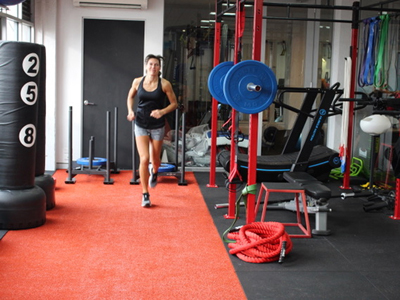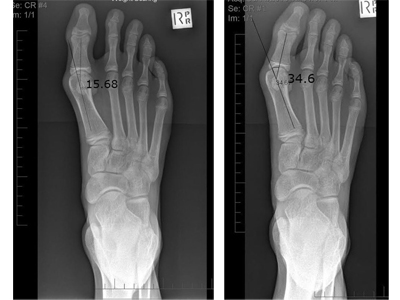Daniel Fitzpatrick Foot Problems Interview

Myths About Feet
Heels cause all of women's foot problems
Not true. Now I'm not saying that heels are good for your feet but many common foot problems are at similar rates in populations that don't wear shoes. Heels can definitely accelerate foot problems but someone still has to have the traits that would cause the foot problem in the first place.
Walking barefoot is bad for you
Not true walking bare foot helps to strength muscles, helps balance and coordination. In some cases it may be uncomfortable but this usually due to tight lower leg muscles. You can fix this in many cases with simply stretching your calves.
You need supportive foot wear otherwise you will get bad feet
Not true in fact recent studies suggest support in most types of supportive foot wear isn't actually doing anything to help control your foot and in fact having less support can help to build strength in the long term.
Foot pain is because you're getting old
Not true foot pain in most cases is due to misalignment (or the bones of your feet being in the wrong place) and as a result flares up the soft tissues which results in pain. The great news it's fixable.
Your feet don't change once you're an adult
Feet definitely change over the course of your life they can change for example arches can definitely get higher or lower. The great news is as practitioners we can help do this in a positive way if foot structures are causing problems.
In fact a great example of feet changing is when women become pregnant as a result of the hormone relaxin which causes the feet to spread and become longer. This can cause a number of issues the great news is we can usually reverse these effects and get the foot to change back to a similar size down the track.
You can't change someone's arch when they're an adult
Yes you can and we do all the time. The arch is quiet a dynamic structure that can adopt a new position with the right influences.
All thongs are bad for you
No in fact there's some fantastic thongs on the market that provide excellent support, in fact they are probably better for you than lots of expensive runners. Birkenstocks are an example of these but there are many good quality thongs on the market starting at about $30. Most people aren't wearing thongs enough to cause a problem anyway.
To fix a foot problem you have to wear special shoes with inserts
This once upon a time was the case but there are plenty of techniques to address the underlying cause without having to be restricted to orthotics or supportive footwear. There are gentle hands on techniques which can improve the structures of the feet along with exercises.
Kids need supportive foot wear
In fact children unless they have specific foot problems get huge advantages in bare feet or lighter shoes that give a barefoot sensation. In fact were finding that heavy supportive shoes in kids can actually impede normal function and interfere with balance and coordination. This is very evident before five but can definitely witness well into teens.
Walking on sand will help any foot pain you have
A common misconception is that sand will help your foot if you have pain. In most cases it will irritate any inflammation that you might have through the structures of your feet. If you have very good feet/ biomechanics then sand can help to strengthen but most people don't fall into that category.
https://sydneybunionclinic.com.au/
Not true. Now I'm not saying that heels are good for your feet but many common foot problems are at similar rates in populations that don't wear shoes. Heels can definitely accelerate foot problems but someone still has to have the traits that would cause the foot problem in the first place.
Walking barefoot is bad for you
Not true walking bare foot helps to strength muscles, helps balance and coordination. In some cases it may be uncomfortable but this usually due to tight lower leg muscles. You can fix this in many cases with simply stretching your calves.
You need supportive foot wear otherwise you will get bad feet
Not true in fact recent studies suggest support in most types of supportive foot wear isn't actually doing anything to help control your foot and in fact having less support can help to build strength in the long term.
Foot pain is because you're getting old
Not true foot pain in most cases is due to misalignment (or the bones of your feet being in the wrong place) and as a result flares up the soft tissues which results in pain. The great news it's fixable.
Your feet don't change once you're an adult
Feet definitely change over the course of your life they can change for example arches can definitely get higher or lower. The great news is as practitioners we can help do this in a positive way if foot structures are causing problems.
In fact a great example of feet changing is when women become pregnant as a result of the hormone relaxin which causes the feet to spread and become longer. This can cause a number of issues the great news is we can usually reverse these effects and get the foot to change back to a similar size down the track.
You can't change someone's arch when they're an adult
Yes you can and we do all the time. The arch is quiet a dynamic structure that can adopt a new position with the right influences.
All thongs are bad for you
No in fact there's some fantastic thongs on the market that provide excellent support, in fact they are probably better for you than lots of expensive runners. Birkenstocks are an example of these but there are many good quality thongs on the market starting at about $30. Most people aren't wearing thongs enough to cause a problem anyway.
To fix a foot problem you have to wear special shoes with inserts
This once upon a time was the case but there are plenty of techniques to address the underlying cause without having to be restricted to orthotics or supportive footwear. There are gentle hands on techniques which can improve the structures of the feet along with exercises.
Kids need supportive foot wear
In fact children unless they have specific foot problems get huge advantages in bare feet or lighter shoes that give a barefoot sensation. In fact were finding that heavy supportive shoes in kids can actually impede normal function and interfere with balance and coordination. This is very evident before five but can definitely witness well into teens.
Walking on sand will help any foot pain you have
A common misconception is that sand will help your foot if you have pain. In most cases it will irritate any inflammation that you might have through the structures of your feet. If you have very good feet/ biomechanics then sand can help to strengthen but most people don't fall into that category.
https://sydneybunionclinic.com.au/
 Interview with Daniel Fitzpatrick, Podiatrist at Alternative Foot Solutions
Interview with Daniel Fitzpatrick, Podiatrist at Alternative Foot Solutions
Question: Why do you believe there is an epidemic of foot problems?
Daniel Fitzpatrick: So there is such a high rate of foot problems because of the rates of poor functioning feet. This is dictated by our genetic traits. But roughly 80% of the population pronates (rolls in too much) and 7-10 % supinates (high arch and their foot is too rigid) only leaving just over 10 % of people with the ideal foot type. As a result if someone either pronates too much or supinates too much they will be more prone to foot problems as a result of the compensations. These compensations tend to result in pain.
One other factor is that we all tend to spend more time sitting whether it be in the car, in the office etc. As a result our muscles tighten and tend to be more prone to inflammation and pain because they become inflexible, as a result of inflexibility they are more prone to minor tears that result in injury.
Question: What foot problems are most common at your practice?
Daniel Fitzpatrick: The two most common are bunions and plantar fasciitis. Bunions affects 1/3 Australians, and over the age of 65 it's up to 70%. A bunion is a deviation of your big toe toward the middle of your foot and can lead to a bony growth and osteoarthritis of the big toe joint.
Bunions is so commonly seen in our practice because the only other option is drastic surgery. We can realign a bunion and address the underlying cause (so avoid long term issues) through a technique called foot mobilisation. This is a technique where we correct the alignment of the joints of the foot and then strengthen the muscles to reinforce this corrected position long term.
The second is plantar fasciitis. Your plantar fascia runs form your heel down to your toes and is a tough tissue that keep the bottom of your foot together. Plantar fasciitis is where you get micro tears along the plantar fascia as a result of the way that you walk and tight calve muscles. We see a lot of this because the way that this is usually treated is through orthotics the downside is that these are very difficult to fit into shoes and as a result women find it difficult to be compliant. Being one of the only practices in new to specialise in a treatment that doesn't rely on orthotics and where women don't have to change their footwear we see this condition a lot.
The other very common condition is hammer toes. This is where your toes curl up as a result of compensating for the way someone stands and walks as a result the toes go into a fixed position. This is caused by misalignment of the foot that affects the way someone stands and walks and causes instability. As a result the toes grip the ground and if they do that for long enough they become into a fixed position.
Question: What causes hammer toes and bunions?
Daniel Fitzpatrick: Bunions is caused by a misalignment of the foot that causes someone to roll in on their big toe causing the big toe to deviate and a bunion to form. This misalignment is inherited but can be fixed long term.
Hammer toes are caused by misalignment of the foot that affects the way someone stands and walks and causes instability. As a result the toes grip the ground and if they do that for long enough they become into a fixed position.
 Question: What options are there for treating hammer toes and bunions?
Question: What options are there for treating hammer toes and bunions?
Daniel Fitzpatrick: The two main options are foot mobilisation and surgery. Foot mobilisation is a gentle hands on technique that corrects the alignment of your feet and then we give exercises to strengthen the relevant muscles to support these changes.
The other is surgery both surgery for bunions and hammers toes involves pinning the toes and is very involved with a significant recovery for both. However if these condition are left long enough this becomes the only option.
Question: How can we all prevent these conditions?
Daniel Fitzpatrick: If you see any signs of either of these conditions I would strongly advised to get assessed by a clinic like us who specialises in these area. The other factors are that if you have a mother, grandmother or other family member that has foot problems unfortunately it means you're more prone to these issues.
Question: What should we do if we have any foot pain?
Daniel Fitzpatrick: I would suggest see a podiatrist and if you would like to avoid orthotics or have bunions or a hammer or would like to avoid orthotics that restrict your footwear make sure to book in at alternative foot solutions as we are the only practice in NSW that offers an alternative that isn't restrictive like orthotics and will allow you to avoid surgery or limiting footwear.
Question: How can we protect our feet when running or training?
Daniel Fitzpatrick: I would stretch more generally speaking after exercise. A lot of issues we see can be avoided through stretching. If you have any concerned I would definitely recommend coming if for an assessment.
Interview by Brooke Hunter
Daniel Fitzpatrick: So there is such a high rate of foot problems because of the rates of poor functioning feet. This is dictated by our genetic traits. But roughly 80% of the population pronates (rolls in too much) and 7-10 % supinates (high arch and their foot is too rigid) only leaving just over 10 % of people with the ideal foot type. As a result if someone either pronates too much or supinates too much they will be more prone to foot problems as a result of the compensations. These compensations tend to result in pain.
One other factor is that we all tend to spend more time sitting whether it be in the car, in the office etc. As a result our muscles tighten and tend to be more prone to inflammation and pain because they become inflexible, as a result of inflexibility they are more prone to minor tears that result in injury.
Question: What foot problems are most common at your practice?
Daniel Fitzpatrick: The two most common are bunions and plantar fasciitis. Bunions affects 1/3 Australians, and over the age of 65 it's up to 70%. A bunion is a deviation of your big toe toward the middle of your foot and can lead to a bony growth and osteoarthritis of the big toe joint.
Bunions is so commonly seen in our practice because the only other option is drastic surgery. We can realign a bunion and address the underlying cause (so avoid long term issues) through a technique called foot mobilisation. This is a technique where we correct the alignment of the joints of the foot and then strengthen the muscles to reinforce this corrected position long term.
The second is plantar fasciitis. Your plantar fascia runs form your heel down to your toes and is a tough tissue that keep the bottom of your foot together. Plantar fasciitis is where you get micro tears along the plantar fascia as a result of the way that you walk and tight calve muscles. We see a lot of this because the way that this is usually treated is through orthotics the downside is that these are very difficult to fit into shoes and as a result women find it difficult to be compliant. Being one of the only practices in new to specialise in a treatment that doesn't rely on orthotics and where women don't have to change their footwear we see this condition a lot.
The other very common condition is hammer toes. This is where your toes curl up as a result of compensating for the way someone stands and walks as a result the toes go into a fixed position. This is caused by misalignment of the foot that affects the way someone stands and walks and causes instability. As a result the toes grip the ground and if they do that for long enough they become into a fixed position.
Question: What causes hammer toes and bunions?
Daniel Fitzpatrick: Bunions is caused by a misalignment of the foot that causes someone to roll in on their big toe causing the big toe to deviate and a bunion to form. This misalignment is inherited but can be fixed long term.
Hammer toes are caused by misalignment of the foot that affects the way someone stands and walks and causes instability. As a result the toes grip the ground and if they do that for long enough they become into a fixed position.
 Question: What options are there for treating hammer toes and bunions?
Question: What options are there for treating hammer toes and bunions? Daniel Fitzpatrick: The two main options are foot mobilisation and surgery. Foot mobilisation is a gentle hands on technique that corrects the alignment of your feet and then we give exercises to strengthen the relevant muscles to support these changes.
The other is surgery both surgery for bunions and hammers toes involves pinning the toes and is very involved with a significant recovery for both. However if these condition are left long enough this becomes the only option.
Question: How can we all prevent these conditions?
Daniel Fitzpatrick: If you see any signs of either of these conditions I would strongly advised to get assessed by a clinic like us who specialises in these area. The other factors are that if you have a mother, grandmother or other family member that has foot problems unfortunately it means you're more prone to these issues.
Question: What should we do if we have any foot pain?
Daniel Fitzpatrick: I would suggest see a podiatrist and if you would like to avoid orthotics or have bunions or a hammer or would like to avoid orthotics that restrict your footwear make sure to book in at alternative foot solutions as we are the only practice in NSW that offers an alternative that isn't restrictive like orthotics and will allow you to avoid surgery or limiting footwear.
Question: How can we protect our feet when running or training?
Daniel Fitzpatrick: I would stretch more generally speaking after exercise. A lot of issues we see can be avoided through stretching. If you have any concerned I would definitely recommend coming if for an assessment.
Interview by Brooke Hunter
MORE



